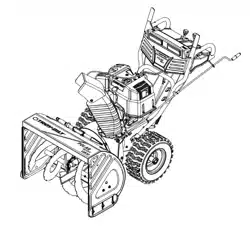Loading ...
Loading ...
Loading ...

9
SECTION 4: OPERATING YOUR SNOW THROWER
Before Starting
WARNING: Read, understand, and follow
all instructions and warnings on the machine
and in this manual before operating.
Gas And Oil Fill-up
Service the engine with gasoline and oil as
instructed in the separate engine manual packed with
your snow thrower. Read instructions carefully.
WARNING: Use extreme care when
handling gasoline. Gasoline is extremely
flammable and the vapors are explosive.
Never fuel machine indoors or while the
engine is hot or running. Extinguish
cigarettes, cigars, pipes and other sources of
ignition.
• A plastic cap is provided inside the fuel fill opening
to protect the tank during manufacturing. Remove
and discard. Use the separate threaded fuel tank
cap to close after fill-up.
To Start Engine
NOTE: If unit shows any sign of motion (drive or
augers) with the controls disengaged, shut engine off
immediately. Readjust as instructed on page 10—Auger
Control Test) and page 11—Drive Control and Shift Lever.
• Attach spark plug wire to spark plug. Make certain
the metal loop on end of the spark plug wire (inside
the boot) is fastened securely over the metal tip on
the spark plug.
• Make certain the fuel shut-off valve, if so equipped,
is in the OPEN (vertical) position.
• Make certain the auger and drive controls are in the
disengaged (up) position.
• Move throttle control up to FAST position. Insert
ignition key into slot and snap in place. See Figure
8. Do not turn key.
NOTE: Engine will not start unless ignition key is
inserted into ignition slot in carburetor cover.
Electric Starter
• Determine that your house wiring is a three-wire
grounded system. Ask a licensed electrician if you
are not certain.
WARNING: The electric starter is
equipped with a grounded three-wire power
cord and plug and is designed to operate on
120 volt AC household current. It must be
used with a properly grounded three-prong
receptacle at all times to avoid the possibility
of electric shock. Follow all instructions
carefully prior to operating the electric starter.
• If your house wiring system is not a three-wire
grounded system, do not use this electric starter
under any conditions.
• If your home electrical system is grounded, but a
three-hole receptacle is not available, one should
be installed by a licensed electrician before using
the electric starter.
• If you have a grounded three-prong receptacle,
proceed as follows:
• Connect power cord to switch box on engine. Plug
the other end of power cord into a three-prong, 120-
volt, grounded, AC receptacle.
• Rotate choke knob to FULL choke position (cold
engine start). If engine is warm, place choke in OFF
position instead of FULL.
• Push primer button two or three times for cold
engine start, making sure to cover vent hole in
primer button when pushing. DO NOT use primer to
restart a warm engine after a short shutdown.
• Push starter button to start engine.
• When engine starts, release starter button, and
move choke gradually to OFF. If engine falters,
move choke immediately to FULL and then
gradually to OFF.
• When disconnecting the power cord, always unplug
from the three-prong receptacle first and then from
the snow thrower.
Recoil Starter
• Rotate choke knob to FULL choke position (cold
engine start). If engine is warm, place choke in OFF
position instead of FULL.
• Push primer button three or four times for cold
engine start. DO NOT use primer to restart a warm
engine after a short shutdown.
NOTE: Always cover vent hole in primer button when
pushing. Additional priming may be necessary for first
start if temperature is below 15°F.
• Grasp starter handle and pull rope out slowly, until
it pulls slightly harder. Let rope rewind slowly.
• Pull starter handle rapidly. Do not allow handle to
snap back. Allow it to rewind slowly while keeping a
firm hold on the starter handle.
• Repeat the previous steps until engine starts.
Loading ...
Loading ...
Loading ...
